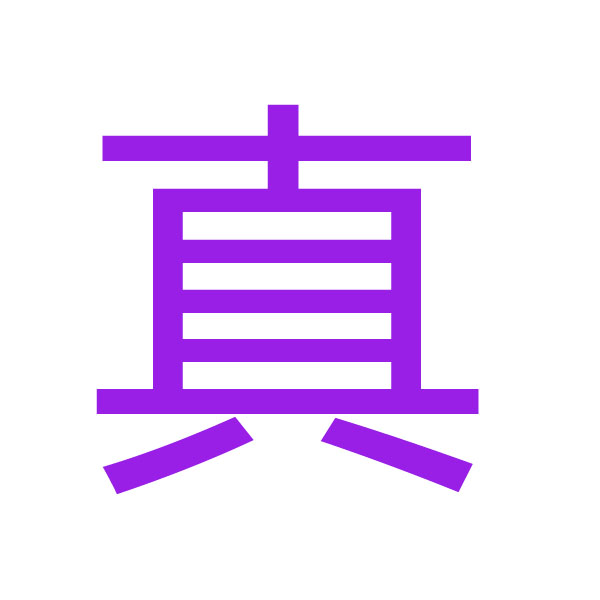
1. Kanji Breakdown: 真
This kanji represents concepts of authenticity, truth, and genuineness at the most fundamental level.
Meaning: Truth, reality, genuineness; pure, true, real. It signifies the true essence of something, without falsehood or alteration.
Reading:
Onyomi (Sino-Japanese reading): シン (shin)
Kunyomi (Native Japanese reading): ま (ma)
The etymology of "真" is interesting. Its ancient form is thought to depict a transformation, perhaps symbolizing the idea of reaching a true or essential state. The top part (匕) may represent a reversed "person" (人), and the bottom (丌) a stand, suggesting a fundamental change to reveal the true nature.
2. Stroke Order and Writing
Learning the correct stroke order is crucial for balanced and beautiful kanji. "真" has 10 strokes.
Here is the stroke order diagram and explanation:
Total Strokes: 10
Start with the top horizontal stroke.
The left vertical stroke.
The right vertical stroke.
The second horizontal stroke.
The third horizontal stroke.
The fourth (bottom) horizontal stroke.
The left-falling diagonal stroke.
The right-falling diagonal stroke.
The left dot.
The right dot.
Key Writing Tips:
The character is built around a central, vertical "box" created by the first six strokes.
The three horizontal strokes inside should be evenly spaced.
The final two dots (strokes 9 & 10) are crucial and give the character a stable, grounded feel.
The overall shape should be symmetrical and well-proportioned.
3. Vocabulary and Example Sentences
Here are some common words using "真" and how to use them in sentences.
Vocabulary
真実 (しんじつ, shinjitsu)
Meaning: Truth, reality.
Example: 真実を話してください。
Romaji: Shinjitsu o hanashite kudasai.
English: Please tell the truth.
真ん中 (まんなか, mannaka)
Meaning: The middle, center.
Example: テーブルの真ん中に花を飾った。
Romaji: Tēburu no mannaka ni hana o kazatta.
English: I placed flowers in the center of the table.
真っ直ぐ (まっすぐ, massugu)
Meaning: Straight (ahead), direct, upright.
Example: この道を真っ直ぐ進んでください。
Romaji: Kono michi o massugu susunde kudasai.
English: Please go straight on this road.
真剣 (しんけん, shinken)
Meaning: Serious, earnest (literally, with a real sword).
Example: 真剣に将来のことを考えよう。
Romaji: Shinken ni shōrai no koto o kangaeyou.
English: Let's think about our future seriously.
真似 (まね, mane)
Meaning: Imitation, mimicry; to imitate.
Example: 彼は先生の口調を真似した。
Romaji: Kare wa sensei no kuchō o mane shita.
English: He imitated the teacher's tone of voice.
真っ白 (まっしろ, masshiro)
Meaning: Pure white, spotlessly white.
Example: 雪で庭が真っ白になった。
Romaji: Yuki de niwa ga masshiro ni natta.
English: The garden turned pure white with snow.
Summary
Kanji: 真
Core Meaning: Truth, Reality, Genuineness. It represents the authentic, unadulterated essence of things.
Readings: On'yomi シン (shin), Kun'yomi ま (ma)
Stroke Order: 10 strokes. Focus on the symmetrical structure, the evenly spaced inner lines, and the final two dots.
This kanji is fundamental for expressing concepts of authenticity, seriousness, and purity. By mastering its stroke order and vocabulary, you will be able to accurately describe the "true" nature of things in Japanese.